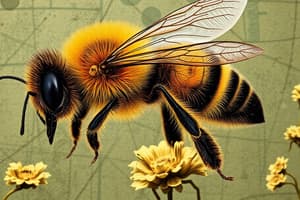Podcast
Questions and Answers
What is the main purpose of bees adding enzymes to nectar during honey production?
What is the main purpose of bees adding enzymes to nectar during honey production?
- To ferment the nectar
- To break down complex sugars (correct)
- To preserve the honey
- To add flavor to the honey
What is the term for the availability and quality of nectar-rich flowers in the surrounding area?
What is the term for the availability and quality of nectar-rich flowers in the surrounding area?
- Colony Strength
- Nectar Flow (correct)
- Honey Yield
- Bee Activity
What is the primary function of the wax cap in honeycomb cells?
What is the primary function of the wax cap in honeycomb cells?
- To preserve the honey (correct)
- To regulate temperature
- To control humidity
- To provide structural integrity
During which step of honey production do bees regurgitate and evaporate the nectar?
During which step of honey production do bees regurgitate and evaporate the nectar?
What is a major threat to honey production?
What is a major threat to honey production?
What do beekeepers assess during quality control?
What do beekeepers assess during quality control?
When do beekeepers typically harvest honey?
When do beekeepers typically harvest honey?
What is the purpose of fanning and wing movement during honey production?
What is the purpose of fanning and wing movement during honey production?
Study Notes
Honey Production
Honey Bee Biology
- Honey bees collect nectar from flowers and transform it into honey through regurgitation and evaporation
- Bees store honey in honeycomb cells within the hive, which are made up of wax produced from their own bodies
Honey Production Process
- Nectar Collection: Bees gather nectar from flowers using their long, tube-shaped tongues (proboscis)
- Enzyme Addition: Bees add enzymes to the nectar to break down complex sugars into simpler ones
- Regurgitation and Evaporation: Bees regurgitate and evaporate the nectar, creating honey, through fanning and wing movement
- Honeycomb Formation: Bees store honey in hexagonal cells within the honeycomb, which are designed for maximum storage and structural integrity
- Capping the Cells: Bees seal the cells with a wax cap to preserve the honey and maintain hive cleanliness
Factors Affecting Honey Production
- Nectar Flow: The availability and quality of nectar-rich flowers in the surrounding area
- Colony Strength: The number and health of bees within the colony
- Weather Conditions: Temperature, humidity, and precipitation can impact nectar availability and bee activity
- Diseases and Pests: The presence of diseases and pests, such as varroa mites, can weaken the colony and reduce honey production
Honey Harvesting
- Timing: Beekeepers typically harvest honey during the peak nectar flow, when the honey is ripe and the colony is strong
- Extraction Methods: Beekeepers use various methods to extract honey from the honeycomb, including crushing, spinning, and filtering
- Quality Control: Beekeepers assess the quality and purity of the honey, including its moisture content, flavor, and aroma
Honey Production
Honey Bee Biology
- Honey bees collect nectar and transform it into honey through regurgitation and evaporation
- Bees produce wax from their own bodies to create honeycomb cells within the hive
Honey Production Process
- Bees gather nectar from flowers using their proboscis
- Enzymes are added to break down complex sugars into simpler ones
- Regurgitation and evaporation create honey through fanning and wing movement
- Honey is stored in hexagonal cells within the honeycomb for maximum storage and structural integrity
- Cells are sealed with a wax cap to preserve honey and maintain hive cleanliness
Factors Affecting Honey Production
- Nectar flow availability and quality impact honey production
- Colony strength, determined by bee number and health, affects production
- Weather conditions, such as temperature, humidity, and precipitation, influence nectar availability and bee activity
- Diseases and pests, like varroa mites, can weaken the colony and reduce honey production
Honey Harvesting
- Harvesting typically occurs during peak nectar flow, when honey is ripe and the colony is strong
- Various extraction methods are used, including crushing, spinning, and filtering
- Quality control involves assessing honey's moisture content, flavor, and aroma
Studying That Suits You
Use AI to generate personalized quizzes and flashcards to suit your learning preferences.
Description
Learn about the process of honey production, from nectar collection to enzyme addition and honeycomb storage. Explore the fascinating biology of honey bees and how they transform nectar into honey.




